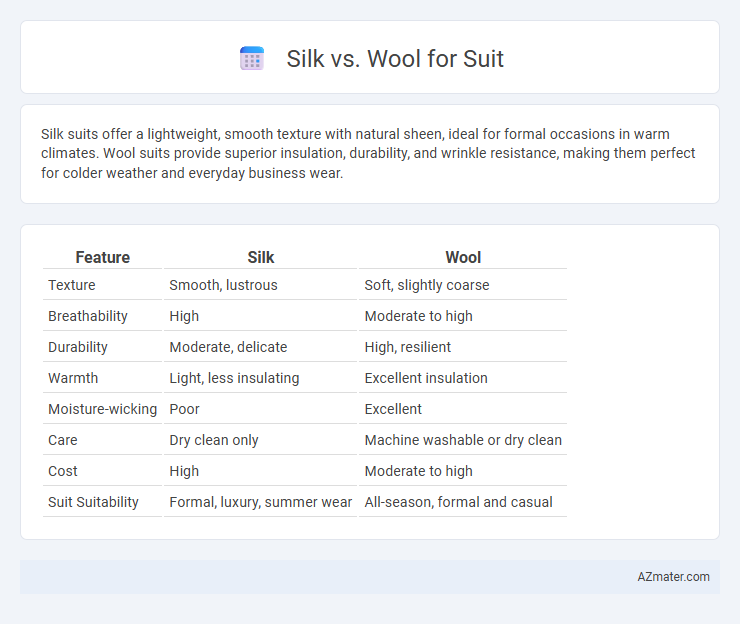Silk suits offer a lightweight, smooth texture with natural sheen, ideal for formal occasions in warm climates. Wool suits provide superior insulation, durability, and wrinkle resistance, making them perfect for colder weather and everyday business wear.
Table of Comparison
| Feature | Silk | Wool |
|---|---|---|
| Texture | Smooth, lustrous | Soft, slightly coarse |
| Breathability | High | Moderate to high |
| Durability | Moderate, delicate | High, resilient |
| Warmth | Light, less insulating | Excellent insulation |
| Moisture-wicking | Poor | Excellent |
| Care | Dry clean only | Machine washable or dry clean |
| Cost | High | Moderate to high |
| Suit Suitability | Formal, luxury, summer wear | All-season, formal and casual |
Introduction: Silk vs Wool Suits
Silk and wool suits offer distinct advantages in fabric performance and appearance; wool provides durability, breathability, and excellent insulation, while silk delivers a luxurious sheen, smooth texture, and lightweight feel. Wool suits are ideal for year-round wear due to their natural moisture-wicking properties and wrinkle resistance, making them a staple in professional wardrobes. Silk suits, often reserved for special occasions, excel in comfort and elegance but require more careful maintenance to preserve their premium quality.
Overview of Silk and Wool Fabrics
Silk fabric, known for its natural sheen and smooth texture, provides lightweight breathability and a luxurious feel, making it ideal for formal wear such as suits in warmer climates. Wool, derived from sheep's fleece, offers exceptional insulation, durability, and wrinkle resistance, which suits colder weather and extended wear. Both fabrics vary in weave and weight, influencing their suitability for different seasons and style preferences in tailored suits.
Comfort and Wearability Comparison
Silk suits offer exceptional softness and breathability, making them ideal for warm climates due to their moisture-wicking properties and smooth texture that feels gentle against the skin. Wool suits excel in temperature regulation, providing warmth in cooler weather while maintaining breathability through natural fiber crimp, offering durability and wrinkle resistance for extended wear. For all-day comfort, wool delivers better insulation and longevity, whereas silk prioritizes lightweight elegance and a luxurious hand feel but may require more delicate care.
Appearance and Aesthetic Appeal
Silk suits exhibit a natural sheen and smooth texture that enhances their luxurious and sophisticated look, making them ideal for formal events and high-end fashion. Wool suits offer a matte finish with rich texture and depth, providing a classic, timeless appearance suitable for both business and casual settings. The choice between silk and wool ultimately depends on the desired aesthetic: silk delivers elegance and shine, while wool ensures a refined, understated style.
Durability and Longevity
Silk suits, known for their luxurious sheen and smooth texture, offer moderate durability but are susceptible to wear and tear over time, especially when frequently worn. Wool suits provide superior durability and longevity due to their natural resilience, wrinkle resistance, and ability to maintain shape, making them ideal for everyday use and extended wear. Investing in high-quality wool ensures a suit that retains its structure and appearance for years, outperforming silk in terms of practical durability.
Climate and Seasonal Suitability
Silk suits excel in warm, humid climates due to their lightweight, breathable fibers that wick moisture and regulate body temperature efficiently. Wool suits are ideal for cooler seasons and cold climates because their dense fibers provide superior insulation and retain heat effectively. Choosing between silk and wool suits depends on the specific seasonal conditions and the need for temperature regulation during wear.
Maintenance and Care Requirements
Silk suits require delicate care, often necessitating dry cleaning to maintain their smooth texture and prevent fabric damage. Wool suits are more durable and can withstand regular professional cleaning, with occasional brushing and spot cleaning to remove dirt and maintain fibers. Proper storage with breathable garment bags helps preserve both silk and wool suits, guarding against moths and moisture.
Cost and Value Considerations
Silk suits generally come with a higher price tag due to the luxurious texture and sheen of the fabric, offering exceptional elegance for formal occasions. Wool suits provide excellent value through durability, breathability, and versatility, making them suitable for year-round wear and various climates. Investing in wool often results in longer-lasting garments with better wrinkle resistance, while silk suits are best reserved for special events where visual impact justifies the cost.
Style Versatility for Occasions
Silk suits offer a luxurious sheen and lightweight feel ideal for formal events and evening occasions, exuding elegance and sophistication. Wool suits provide superior versatility, suitable for a broad range of settings from business meetings to casual gatherings due to their durability and excellent drape. Choosing wool enhances adaptability in style, while silk elevates distinctiveness in dress codes requiring refined sophistication.
Conclusion: Choosing Between Silk and Wool Suits
Silk suits offer a luxurious sheen and lightweight feel ideal for formal, warm-weather events but lack the durability and wrinkle resistance of wool. Wool suits provide superior breathability, warmth, and durability, making them a versatile choice for year-round wear and varied climates. Selecting between silk and wool suits depends on the occasion, comfort preference, and desired longevity of the garment.

Infographic: Silk vs Wool for Suit
 azmater.com
azmater.com